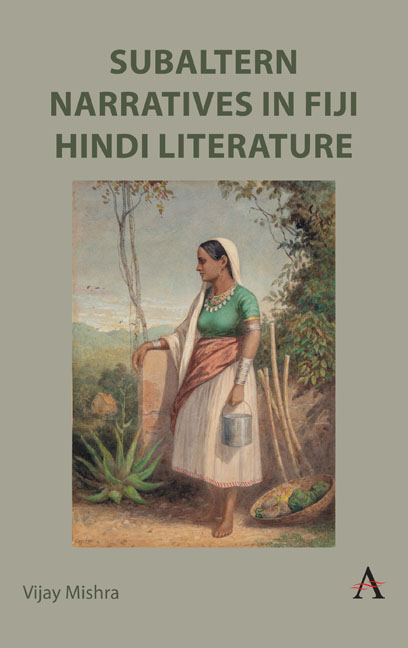Book contents
- Frontmatter
- Dedication
- Contents
- Acknowledgements
- A Note on Transliteration
- Map of Fiji
- Foreword: On the Genesis of Ḍaukā Purān
- Introduction: Reading the Fiji Hindi Demotic
- 1 Introduction: Reading the Fiji Hindi Demotic
- 2 The Moment of Ḍaukā Purān
- 3 Fījī Māṁ: The Female Subaltern Epic
- Conclusion: Can the Subaltern Speak? Language Itself Speaks
- Appendix: Glossary of Fiji Hindi and Fijian Words
- Select Bibliography
- Index
1 - Introduction: Reading the Fiji Hindi Demotic
Published online by Cambridge University Press: 13 April 2024
- Frontmatter
- Dedication
- Contents
- Acknowledgements
- A Note on Transliteration
- Map of Fiji
- Foreword: On the Genesis of Ḍaukā Purān
- Introduction: Reading the Fiji Hindi Demotic
- 1 Introduction: Reading the Fiji Hindi Demotic
- 2 The Moment of Ḍaukā Purān
- 3 Fījī Māṁ: The Female Subaltern Epic
- Conclusion: Can the Subaltern Speak? Language Itself Speaks
- Appendix: Glossary of Fiji Hindi and Fijian Words
- Select Bibliography
- Index
Summary
Imagine a Spanish reader faced with the first part of Miguel de Cervantes’ Don Quixote on its publication in 1605 (the second part is published in 1615). This reader (whom I assume is male) would have read the first part of Cervantes’ novel (running into some 500 pages) with some familiarity with the genres of narrative fiction. He would have read the anonymously written picaresque tale Lazarillo de Tormes (1554), a text noted a number of times in Don Quixote itself, and Francisco de Quevedo's The Swindler, which, although written in 1608, possibly earlier, remained unpublished until 1626 but may have circulated in holograph versions. This reader's frame of reference, indeed his horizon of expectations for a novel that parted company from the earlier celebrated chivalric romances noted in Cervantes’ own Prologue, would have been limited to these works. Cervantes, whose primary target in his picaresque novel is the enormously popular fourteenth-century Spanish chivalric romance Amadís de Gaula (Amadís of Gaul) and whose work ‘definitively initiates [the] break between the romance and the novel’, had made his point of departure from the established conventions of the genre of romance clear in his Prologue. Like Socrates appropriating someone else's voice, Cervantes wrote,
And since this work of yours intends only to undermine the authority and wise acceptance that books of chivalry have in the world and among the public […] you should strive, in plain speech, with words that are straightforward, honest, and well-placed […]. Another thing to strive for: reading your history should move the melancholy to laughter […] and if you accomplish this, you will have accomplished no small thing.
The imaginary Spanish historical reader I speak of had two relatively minor works as his point of reference (if he had seen Quevedo's tale in holograph), and he would have asked the usual questions: ‘Is Cervantes better?’ ‘Can he improve on the earlier works?’ ‘Is the content serious?’ ‘Can a modern, colloquial language such as Spanish carry the weight of high literature?’ ‘Can a work of literary art be written in a low mimetic mode, and moreover in the vernacular?’
- Type
- Chapter
- Information
- Subaltern Narratives in Fiji Hindi Literature , pp. 17 - 42Publisher: Anthem PressPrint publication year: 2024



